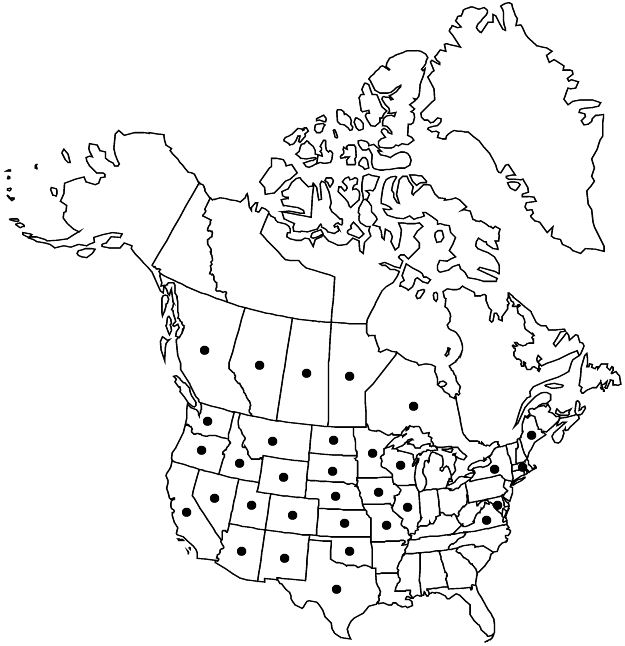Potentilla rivalis
in J. Torrey and A. Gray, Fl. N. Amer. 1: 437. 1840.
Stems decumbent to erect, sometimes prostrate, (0.5–) 1–4 (–7) dm, hairs at base not stiff, not tubercle-based, glands absent or sparse, inconspicuous. Leaves ternate, palmate, or subpalmate (with distal leaflets ± confluent), basal 3–15 (–25) cm, cauline 2–7 (–12) cm; petiole: basal 1–9 (–16) cm, cauline 0.5–4 (–8) cm, long hairs usually common to abundant, ascending to spreading, 0.5–1.5 mm, usually ± weak, ± crisped hairs common to abundant, glands absent or sparse, inconspicuous; leaflets 3–5 (–7), at tip to distal 1/5 (basal) or 1/2 (cauline) of leaf axis, separate to ± overlapping, largest ones oblanceolate-elliptic to obovate, (0.5–) 1–5 (–6) × 0.5–2 (–2.5) cm, distal 1/2–3/4 of margin evenly to unevenly incised 1/3–1/2 to midvein, sometimes cleft nearly to base, teeth 3–8 per side, surfaces moderately to abundantly hairy, glands absent or sparse. Inflorescences (5–) 20–100+-flowered. Pedicels 0.2–1 (–2) cm. Flowers: epicalyx bractlets narrowly elliptic to ovate, (1.5–) 2–4 (–6) × 0.8–1.5 mm; hypanthium (2–) 3–5 mm diam.; sepals 3–5 mm, apex broadly acute to obtuse; petals pale-yellow to yellow, broadly oblong-obovate, 1.5–2 × 1 mm; stamens (5–) 10 (–15), filaments 0.4–0.9 mm, anthers 0.2–0.3 mm; carpels 40–100, styles 0.5–0.6 mm. Achenes yellowish, 0.7–0.9 mm, ± smooth, without a corky protuberance. 2n = 14, 70.
Phenology: Flowering spring–summer.
Habitat: Moist meadows, stream banks, lakeshores, gravel bars in flood plains, drying marshes, open areas in river-bottom forests
Elevation: 200–2400 m
Distribution

Alta., B.C., Man., Ont., Sask., Ariz., Calif., Colo., Idaho, Ill., Iowa, Kans., Maine, Md., Mass., Minn., Mo., Mont., Nebr., Nev., N.Mex., N.Y., N.Dak., Okla., Oreg., S.Dak., Tex., Utah, Va., Wash., Wis., Wyo., Mexico (Baja California)
Discussion
Potentilla rivalis is most abundant in central and western North America; reports of occurrences in more eastern states (including those listed here) need confirming, as P. rivalis and P. norvegica often have been confused. Potentilla leucocarpa Rydberg was provided as a superfluous replacement name for P. millegrana; specimens annotated by Rydberg with this name include both P. biennis and P. rivalis.
Potentilla rivalis is sometimes divided into three species or varieties (for example, H. J. Scoggan 1978–1979). In a strict sense, var. rivalis has subpalmately compound (5-foliate) leaves. Variety milligrana, the most common phase, has 3-foliate leaves. Plants with both 3- and 5-foliolate leaves are var. pentandra, which also tends to have five stamens, though this latter character is not correlated with the leaf features. On the Great Plains, where var. pentandra is confined, all three expressions are often found in a single population (R. L. McGregor 1986b).
Selected References
None.
Lower Taxa
"thin" is not a number."dm" is not declared as a valid unit of measurement for this property."(" is not declared as a valid unit of measurement for this property."dm" is not declared as a valid unit of measurement for this property."papillate-swollen" is not a number."dm" is not declared as a valid unit of measurement for this property.